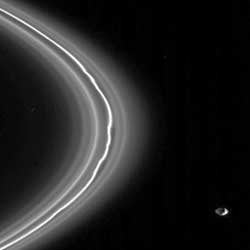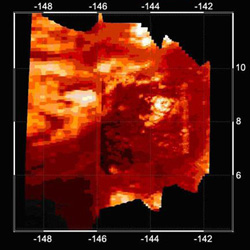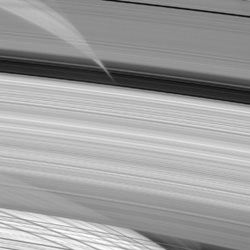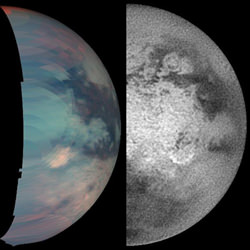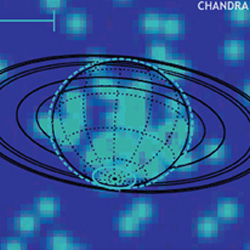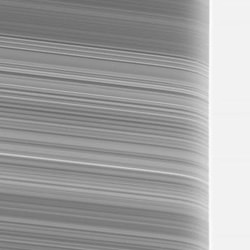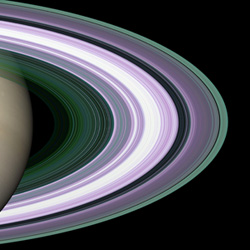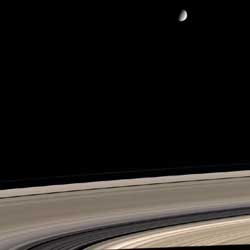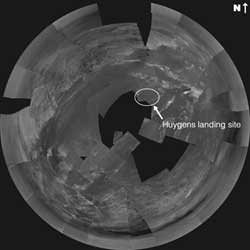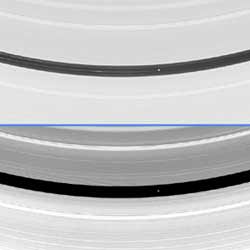
Saturn’s moon Pan makes ripples in the rings as it orbits the planet. Image credit: NASA/JPL/SSI. Click to enlarge.
Saturn’s moon Pan is seen here orbiting within the Encke Gap in Saturn’s A ring in two differently processed versions of the same Cassini image. The little moon is responsible for clearing and maintaining this gap, named for Johann Franz Encke, who discovered it in 1837. Pan is 20 kilometers (12 miles) across.
The top image reveals two of the faint, dusty ringlets that occupy the gap along with Pan. One of the ringlets occupies nearly the same orbit as Pan, while the other is closer to the gap’s inner edge. Not only do the ringlets vary in brightness, but they also appear to move in and out along their length, resulting in notable “kinks,” which are similar in appearance to those observed in the F ring (see PIA06585). One possible explanation for the complex structure of the ringlets is that Pan may not be the only moonlet in this gap.
Pan is responsible for creating stripes, called ‘wakes,’ in the ring material on either side of it. Since ring particles closer to Saturn than Pan move faster in their orbits, these particles pass the moon and receive a gravitational “kick” from Pan as they do. This kick causes waves to develop in the gap where the particles have recently interacted with Pan (see PIA06099), and also throughout the ring, extending hundreds of kilometers into the rings. These waves intersect downstream to create the wakes, places where ring material has bunched up in an orderly manner thanks to Pan’s gravitational kick.
In the bottom image, the bright stripes or wakes moving diagonally away from the gap’s edges can be easily seen. The particles near the inner gap edge have most recently interacted with Pan and have just passed the moon. Because of this, the disturbances caused by Pan on the inner gap edge are ahead of the moon. The reverse is true at the outer edge: the particles have just been overtaken by Pan, leaving the wakes behind it.
This image was taken in visible light with the Cassini spacecraft narrow-angle camera on May 18, 2005, at a distance of approximately 1.6 million kilometers (1 million miles) from Pan and at a Sun-Pan-spacecraft, or phase, angle of 44 degrees. The image scale is 9 kilometers (6 miles) per pixel.
The Cassini-Huygens mission is a cooperative project of NASA, the European Space Agency and the Italian Space Agency. The Jet Propulsion Laboratory, a division of the California Institute of Technology in Pasadena, manages the mission for NASA’s Science Mission Directorate, Washington, D.C. The Cassini orbiter and its two onboard cameras were designed, developed and assembled at JPL. The imaging team is based at the Space Science Institute, Boulder, Colo.
For more information about the Cassini-Huygens mission visit http://saturn.jpl.nasa.gov. For additional images visit the Cassini imaging team homepage http://ciclops.org.
Original Source: NASA/JPL/SSI News Release

